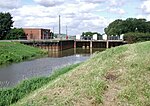Southcoates

Southcoates is an urban area in the eastern part of Kingston upon Hull, England. A named habitation at Southcoates dates to at least the 11th century, during the medieval period the place was a small hamlet, associated with Drypool. The urban growth of Hull expanded over Southcoates in the late 19th and early 20th century, and the place subsequently gave its name to council wards. The area of Southcoates centred on the former village is predominantly urban housing. The southern part of the Southcoates area is adjacent to the Humber Estuary, and was originally wetlands; a large amount of land was reclaimed southwards on the foreshore during the construction of the Alexandra Dock in the 1880s; this land and adjacent areas are in predominantly industrial and dock use.
Excerpt from the Wikipedia article Southcoates (License: CC BY-SA 3.0, Authors, Images).Southcoates
Southcoates Lane, Hull Garden Village
Geographical coordinates (GPS) Address Nearby Places Show on map
Geographical coordinates (GPS)
| Latitude | Longitude |
|---|---|
| N 53.7581 ° | E -0.29409 ° |
Address
Southcoates Lane
Southcoates Lane
HU9 3TN Hull, Garden Village
England, United Kingdom
Open on Google Maps








